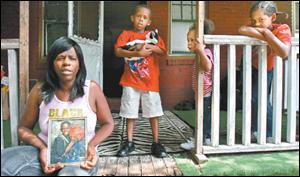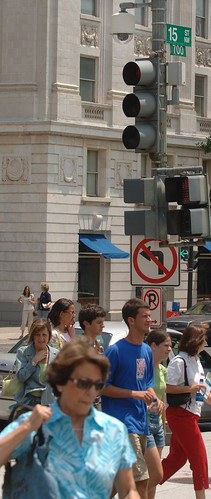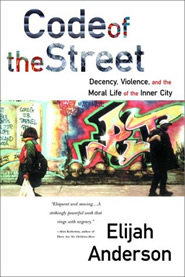Crime Time #4
 Eric Mencher, Inquirer. Geraldine Thomas holds a photo of her son Jamil taken about four years before he committed murder at age 15. He is now serving a life sentence.
Eric Mencher, Inquirer. Geraldine Thomas holds a photo of her son Jamil taken about four years before he committed murder at age 15. He is now serving a life sentence.Updated-----
The Post has a story on the front page of the Metro section covering some of these same issues. See "Crime Measures Derided as Too Little, Too Late."
____________________
I have loosened the reins on the companion blog Urban Agenda, which has a new contributor, "soul searcher." He wrote a piece on DC's crime emergency, which really ought to be in this blog, but I didn't write it...
(The Urban Agenda blog is oriented to developing a progressive pro-urban agenda both at the local level as well as the level of national politics, the presidential candidate selection process, and the inclusion of urban planks in the development of national party platforms.) Scripps-Howard News Service photo. Surveillance Camera in Downtown DC.
Scripps-Howard News Service photo. Surveillance Camera in Downtown DC.
2. One of the things soul searcher is interested in is the impact of surveillance cameras on crime vs. concerns over civil liberties. I have the same concerns. The Washington Times had two articles on this issue yesterday, D.C. police gain wide control of monitors and this piece, "Under Surveillance: Government spy cameras proliferate," from the Scripps-Howard News Service.
3. Also, Philadelphia is truly experiencing a crime emergency, but the depth of the problem hasn't made it to the national newspapers, unlike DC's relatively minor issues (which are really about the leakage of crime into areas normally not experiencing it). (Sam Smith's City Desk and Duncan Spencer, the Capitol Hill columnist for the paper The Hill, are writing about this aspect of the DC problem.)
Yesterday's Inquirer had a long feature on juvenile perpetrators. They interviewed 7 people incarcerated for crimes, including murder, that they committed as juveniles, in "Snared by the street: Bad breaks, worse choices, few regrets and a relentless undertow." From the article:
Middle school meltdown. Seated in a tiny, brightly lit room reserved for lawyers meeting their clients at Pine Grove prison, Jamil — an 18-year-old with a hardened demeanor — recalls that he was a good student, "then in middle school, I started messing up."
Jaana Juvonen, chair of developmental psychology at UCLA and coauthor of a Rand Corp. study of middle school issues, said children face major challenges when they move from elementary school to the much larger and anonymous world of middle school.
"Lack of close relationships to adults — parents or teachers — at this transitional phase is a major risk factor," Juvonen said. "This is where many of our urban middle schools fail us: They could serve as buffers, but instead they appear to increase the risks for some youth."
All six inmates described their middle school years generally as the time they strayed. Jamil's school records show that, although he wasn't a perfect child in elementary school, he experienced a dramatic change as he entered adolescence.
And:McJobs are for squares. The main job on the Street is drug dealer.
"By selling drugs," wrote University of Pennsylvania professor Elijah Anderson, an authority on urban street life, young inner-city males "have a chance to put more money into their pockets than they could get by legal means, and they present themselves to peers as hip, in sharp contrast to the square image of those who work in places like McDonald's and wear silly uniforms."
Anthony Chisholm, 18, once a successful businessman of the Street, now reads Adam Smith's The Wealth of Nations in his cell, where he's doing time for armed robbery. He was 14 when he got his introduction to market forces — selling crack on "the Avenue," Lancaster Avenue. His father was out of work and his parents could barely pay the bills. "Somebody I knew gave me some drugs and it was history," said Anthony, a crafty West Philadelphian with an easy laugh.
Finally:
Guns change the equation. In the poorest urban neighborhoods, many youths use violence to establish and maintain their identities and win respect, said Deanna L. Wilkinson, an expert on juvenile violence, formerly at Temple University and now at Ohio State.
"Over time, it's how they define themselves," she said. "Those who do not conform are highly likely to be victimized." In a way, it's not much different from the school yard. You have bullies. You have children who get picked on. And you have those caught in between. Guns change the equation.
4. The Philly stuff is relevant because Matthew Yglesias has a piece in DCist about a study that shows a 3% drop in crime from a roughly 10% increase in policing. He thinks that adding 1,600 police officers is a good thingfor that kind of return. I argue that it's likely we can great greater return from $128 million annually (the cost, minimum of adding this number of police officers), by addressing more broadly the problems that "produce: crime.Last week, I mentioned the Respect Action Plan in the United Kingdom. It appears to be a more holistic approach to crime and anti-social behavior. It'll take longer to yield results, but they are likely to be fundamental improvements. Just dealing with middle schools seems to be an approach that would begin to yield results. My idea of a co-operative high school education program, for students who feel compelled to earn money, etc. The Respect Action Plan has six main strands:
- Supporting families
- A new approach to the most challenging families
- Improving behaviour and attendance in schools
- Activities for children and young people
- Strengthening communities
- Effective enforcement and community justice
And I am all for putting point six: "Effective enforcement and community justice;" first, at least right now.

5. I write about Elijah Anderson all the time. Professor Anderson teaches at the University of Pennsylvania and is author of Code of the Street: Decency, Violence and the Moral Life of the Inner City. The Philadelphia Inquirer is sponsoring an online Q&A Forum with Professor Anderson throughout this week. Here's one of his answers, which confirms why I think "the problem" is more than just adding more police, it's dealing with structural poverty, Dr. Anderson writes:
Dear Donna: Structural poverty is strongly associated with urban violence. And it would be a mistake to attribute "too much" to race as a reason for violence in inner city neighborhoods, but race is an important and undeniable factor in this equation. Most of the perpetrators and victims of these killings are young, black, and male. Also, members of the black community are long-term victims of racial discrimination and economic marginalization. And, as far as "aid" goes, there is most definitely a constructive role to be played by non-blacks. The "source of aid" can be any color, for those who are truly disadvantaged and in real need of aid worry little about the color of the benefactor. Thank you for writing. With best wishes, Elijah Anderson
Submit your own questions, read the forum, and as importantly, read Dr. Anderson's book. It's at the MLK Library. You can check it out.
Index Keywords: public-safety



0 Comments:
Post a Comment
<< Home